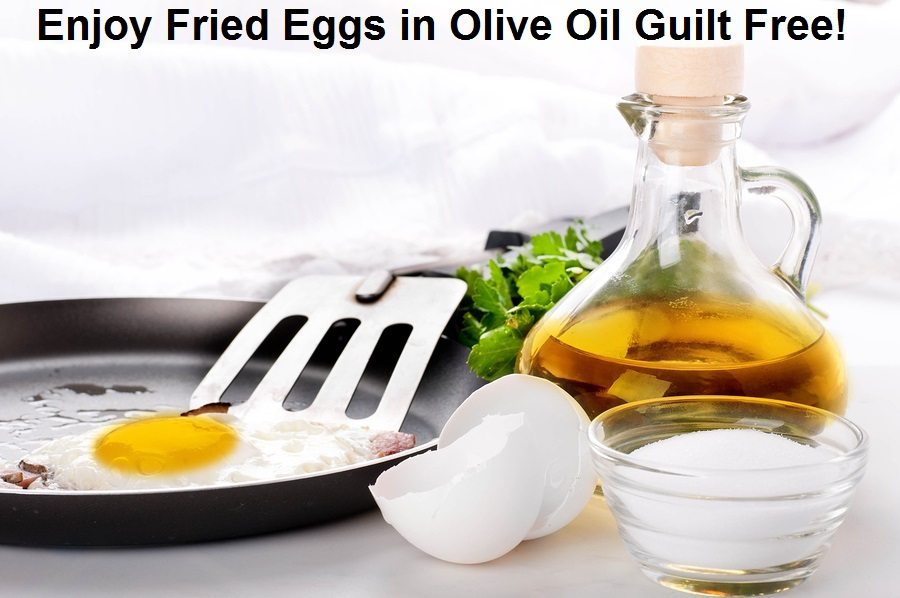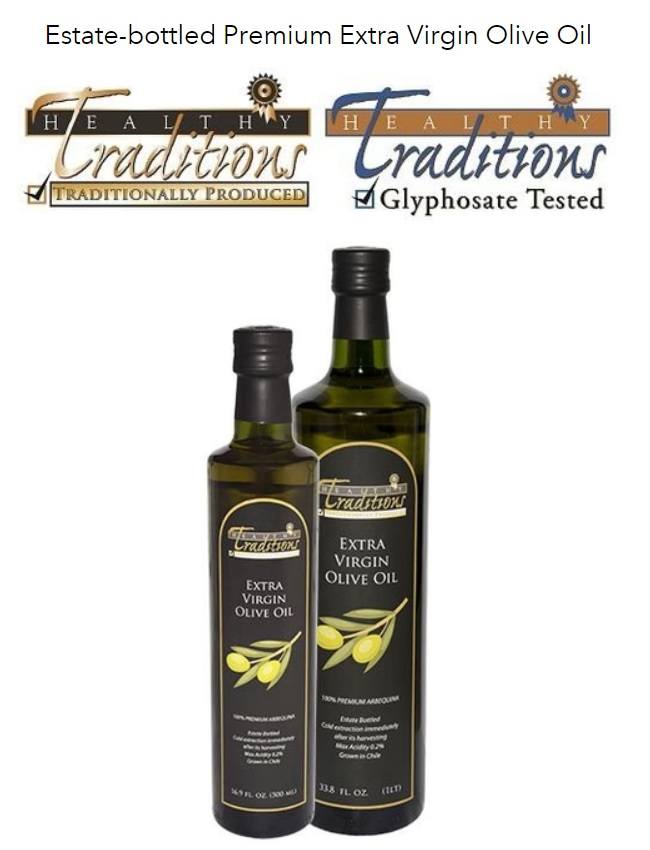
Just as the myths saying eggs are unhealthy and that we should reduce salt in our diet have been proven false, so too is the myth that olive oil should not be used in cooking.
Editor’s Note: We are republishing the information here that we originally published 10 years ago by the late John P. Thomas.
Myth Buster: Olive Oil is One of the Safest Oils for Frying and Cooking
by John P. Thomas
Health Impact News
One of the most common myths perpetrated on the Internet is that while olive oil is healthy, it should not be used for cooking or frying. The belief is that somehow the high heat used in cooking or frying makes olive oil unhealthy. However, this belief is not consistent with historical uses of olive oil in Mediterranean cuisine, nor with a wide body of published research.
Olive oil is not only safe for cooking, but it is recommended by scientists and olive oil experts for high temperature frying! The notion that extra virgin olive oil should never be heated or used for cooking is not supported by research.
Dr. Mary Enig, author of Know Your Fats, is one of America’s foremost experts on healthy fats and oils. She recommends her own personal blend of oils including using olive oil for cooking. She states,
“A unique blend of oils that can be used for sautéing and light frying is one that is a blend of coconut oil (one-third), sesame oil (one-third), and olive oil (one-third). It is easy to make up in small portions ranging from a single tablespoon measure (one teaspoon of each oil) to a pint and a half size (one cup of each oil).”1
Dr. Enig’s recommendation is supported by a wide body of peer-reviewed published research. The high levels of antioxidants present in the highest quality olive oils, usually classified as extra virgin olive oils, are what make olive oil heat stable and an excellent choice for frying or cooking.
A study reported in the Journal of Agricultural and Food Chemistry tested the effects of continuously heating virgin olive oil for 36 hours to measure how the oil degraded. The scientists reported:
“Two monovarietal extra virgin olive oils from Arbequina and Picual cultivars were subjected to heating at 180 degrees C (356 degrees F) for 36 h. Oxidation progress was monitored by measuring oil quality changes (peroxide value and conjugated dienes and trienes), fatty acid composition, and minor compound content. … From these results, we can conclude that despite the heating conditions, VOO (virgin olive oil) maintained most of its minor compounds and, therefore, most of its nutritional properties.”2
Oxidized fats, which are primarily derived from polyunsaturated oils such as corn and soybean oils, are linked to inflammation and various diseases.
Studies have been conducted comparing virgin olive oil with sunflower oil (a polyunsaturated oil) and cooking oils where antioxidants were added. These antioxidants, which are present naturally in high quality olive oils, protect against oxidative stress and inflammation when high heat is applied to the oils.3
In fact, the antioxidants present in olives are so powerful in resisting oxidation due to heat, that they are added to other cooking oils to make them more stable when cooking.4
The International Olive Oil Council (IOOC) provides information about the maximum temperature that can be used when cooking with virgin olive oil.
“When heated, olive oil is the most stable fat, which means it stands up well to high frying temperatures. Its high smoke point (410ºF) 210ºC is well above the ideal temperature for frying food (356ºF) 180ºC. The digestibility of olive oil is not affected when it is heated, even when it is re-used several times for frying.”5
In a nutshell, virgin olive oil can safely be used for cooking and even deep frying. The oil can be reused more than once, and the oil does not seriously degrade in normal household cooking. Olive oil is sensitive to sunlight, however, and is therefore usually packaged in tinted bottles.
Richard Gawel, an internationally known olive oil expert, also recommends the use of olive oil for cooking. He is a consultant taster and blender for a number of Australian olive oil companies, and has been the presiding judge of major olive oil shows in Australia and New Zealand, as well as the Los Angeles International Extra Virgin olive oil show.6
These are the answers that Richard Gawel provides to commonly asked questions about cooking with olive oil.
Can I use extra virgin olive oils for frying?
Yes, but to be honest, refined olive oils (that is those labeled as ‘Pure’ or ‘Light’) are probably a more cost effective alternative when more than shallow frying. Refined olive oils also begin to smoke at a higher temperature than most extra virgin olive oils, making them more suited to deep frying. However, extra virgin olive oils are a far better alternative when shallow frying. It is commonly thought that extra virgin olive oil smokes at a low temperature. However, it is a fact that the lower the free fatty acidity (FFA) i.e. better oils, the higher the temperature at which the oil will begin to smoke. Therefore if you purchase high quality oil with an FFA less than 0.2%, then it will start to smoke at a temperature around 20C higher than your average supermarket EV imported from the EU. That’s a lot in culinary terms.
Can I reuse olive oil?
Yes, extra virgin olive oils can be reused a few times. However, keep in mind that each time an oil is heated and cooled it will lose some of its aroma, flavour, freshness and health giving polyphenols and tocopherol. … However, recent research has shown that the important antioxidant called oleocanthal loses its anti-inflammatory activity under even mild short term heating.
Do trans fats form in olive oil when it is heated?
No they don’t. Trans fats form when any edible oil is subjected to an industrial process called hydrogenation designed to turn liquid oil into an edible fat that is solid at room temperature – that is margarine. The hydrogenation process involves heating up oil under extreme pressure and then bubbling hydrogen gas through it in the presence of a Palladium metal catalyst. For trans fats to form all of these conditions must be in place – heat and pressure and hydrogen gas and an appropriate catalyst. It just can’t happen in your kitchen. The vast majority of trans fats in the average persons diet arise from fast foods, cheap margarines, or more commonly commercial baked products and crackers.”7
The common myth that olive oils are not suitable for cooking or frying is an unfortunate belief, particularly for those eating out at restaurants who want to avoid toxic GMO cooking oils such as corn, soybean, and canola. Many restaurants stock olive oil, and it is probably your best choice when ordering anything fried in restaurants, if the chef or cooks will accommodate your request. Saturated fats such as coconut oil are still the best choice for high heat cooking, but very few restaurants are stocking saturated fats yet these days, and we should not fear adding a high quality olive oil to our home kitchen cooking oils.
The olive oils with the highest levels of antioxidants, and therefore the most heat resistant to high-heat cooking or frying, are generally extra virgin olive oils. Unfortunately, many olive oils available in the market are adulterated and mislabeled extra virgin olive oils. See: Extra Virgin Olive Oil Fraud: A Guide to Purchasing Olive Oil
References
1. Know Your Fats, Mary Enig, Ph.D., 2010, pp 197.
2. “How heating affects extra virgin olive oil quality indexes and chemical composition,” Y. Allouche, A. Jiménez, J. J. Gaforio, M. Uceda, G. Beltrán, J Agric Food Chem, 2007 Nov 14;55(23):9646-54. Epub 2007 Oct 13, PMID: 17935291
3.”The antioxidants in oils heated at frying temperature, whether natural or added, could protect against postprandial oxidative stress in obese people.” Perez-Herrera A, Food Chem. 2013 Jun 15;138(4):2250-9
4.” Influence of simulated deep frying on the antioxidant fraction of vegetable oils after enrichment with extracts fromolive oil pomace.” Orozco-Solano MI, Priego-Capote F, Luque de Castro MD. J Agric Food Chem. 2011 Sep 28;59(18):9806-14
5. “Frying with Olive Oil,” International Olive Oil Council, http://www.internationaloliveoil.org/estaticos/view/85-frying-with-olive-oil,”
6. http://www.oliveoilschool.org/instructor/richard-gawel/
7. “Extra Virgin Olive Oil Frequently Asked Questions,” Richard Gawel, 2009. http://www.aromadictionary.com/oliveoilfaq.html
See Also:
Olive Oil Benefits from Sesame Oil Blending While Extra Virgin Olive Oil Resists Oxidation during Deep Frying – Molecules. 2023 May 24
Extra Virgin Olive Oil Fraud: A Guide to Purchasing Olive Oil
by John P. Thomas
Health Impact News
Do you trust the label on your Extra Virgin Olive Oil? Numerous scandals have been uncovered over the last twenty years which have revealed that many extra virgin olive oils being sold in the United States do not meet the high standard for this product. Many have been adulterated with lower grade olive oils or with nut and seed oils. Others simply have serious flavor and aroma defects, which should prevent them from being called “extra virgin.” The controversy continues to this day.
On March 4, 2014, the beginning stage of a class action law suit was undertaken to bring charges against a company for selling a product labelled as “pure olive oil” when the oil was extracted from olive pomace by means of chemical solvents and extreme high temperatures. Olive pomace is the solid residue that is left over from the traditional production of olive oil. The class action will allege fraud, negligent misrepresentation and breach of warranty under New York and New Jersey law.
“In a pair of rulings, Judge Rakoff of the Southern District of New York denied Kangadis Foods, Inc.’s motion for summary judgment and granted plaintiffs’ motion for class certification in an action alleging fraud, negligent misrepresentation and breach of warranty under New York and New Jersey law based on marketing pomace oil as “100% Pure Olive Oil.” See Ebin v. Kangadis Food Inc., 13 CIV. 2311 JSR, 2014 WL 737878 (S.D.N.Y. Feb. 25, 2014) and Ebin v. Kangadis Food Inc., 13 CIV. 2311 JSR, 2014 WL 737960 (S.D.N.Y. Feb. 25, 2014).”1
In a 2012 article that appeared in “The New Yorker,” Tom Mueller provided an update to the olive oil adulteration problem which he first described in his 2007 book, Extra Virginity: The Sublime and Scandalous World of Olive Oil. His book exposed the contamination of extra virgin olive oil with other types of plant oils and the misuse of the label “extra virgin.” Tom Mueller states:
“There’s a strong downward pressure on olive-oil quality, especially among the huge Spanish-, Portuguese-, and Italian-owned olive-oil traders and bottling companies. There is a massive output of low-grade olive oils, particularly in Spain and North Africa but throughout the E.U., which producers are selling as “extra virgin” olive oil, even though this low-grade oil doesn’t meet the requirements of the extra-virgin grade. … So, while the best extra-virgin olive oils in history are now being made, more and more low-grade oils are also being included in the category, stretching it beyond all meaning.”2
A 2010 study conducted by the Olive Center at the University of California at Davis, tested a selection of extra virgin olive oils purchased from California grocery stores. They were testing to determine whether products marked as “extra virgin olive oil” actually met the international extra virgin standard.
“The research team found that 69 percent of the imported oils sampled, compared with just 10 percent of the California-produced oils sampled, failed to meet internationally accepted standards for extra virgin olive oil.”3
A 2012 report on the findings from a second study conducted by the UC Davis Olive Center revealed further distressing news about olive oil that was sold to restaurants and food-service operations. Twenty-one olive oil brands were examined. Of these, 15 were marketed as extra virgin. In order for an olive oil to be labelled “extra Virgin” it must pass a chemical analysis and a sensory analysis. The study found that,
- All but one of the oils marketed as extra virgin passed commonly used USDA chemistry standards for quality.
- Despite this, nine (60 percent) of the samples failed the USDA sensory standards for extra virgin. (Sensory standards measure flavor, aroma, appearance, and physical characteristics of the oil.)
- The most common sensory defects were flavors and aromas described as rancid, fusty or muddy, and musty. Some of the oils tested were so defective that the sensory panelists classified them as lamp oil, considered by USDA standards to be unfit for human consumption without further refining.
- These nine oils also failed to pass the chemical tests for the compound diacylglycerol, a standard adopted by the Australian Olive Association for extra virgin.
- Chemical purity tests indicated that one of the 15 samples labeled as extra virgin and one of the six samples not labeled as extra virgin had been adulterated with cheap, refined canola oil.”4
How to Purchase Authentic Extra Virgin Olive Oil
Don’t be dismayed by the corruption! You can still buy high quality extra virgin olive oil!
Before you decide to never buy extra virgin olive oil again, please keep in mind that even though some brands failed the test, there are many exceptionally fine brands of extra virgin olive oil produced in the United States and in Europe, which meet the standards. The remainder of this article will help you learn about the qualities that should be found in extra virgin olive oil, and will provide you with suggestions for making an informed purchase.
In order to become a savvy consumer and to bring home what you intended to purchase, it will help you to learn a little bit about the terminology of the olive oil trade. You will find olive oil labels that tell you that the oil in the bottle is: extra virgin olive oil, virgin olive oil, olive oil, pure olive oil, light olive oil, and Olive-pomace. The last type, “Olive-pomace”, technically should not be called olive oil, because it is extracted with chemical solvents from the industrial waste that is produced by standard olive oil manufacturing. There will be more information about Olive-pomace later in this article, because it is being used to adulterate higher grade olive oils and is believed by some to have possible health risks.
Extra virgin is the highest quality and most expensive olive oil. It should have no defects and should have a high organoleptic profile. In other words, it should not have defects such as: being musty (having a moldy flavor or aroma), being fusty (having a fermented smell similar to sweaty socks), or having a winey flavor. On the positive side it should have a collection of qualities that stimulate and satisfy the senses of taste, smell, vision, and the physical sensation of the mouth. These sensory qualities are affected by climate, soil, variety of olive tree, time of harvest, and production practices of the producer.
This is how the “Olive Oil Times,” defines extra virgin olive oil:
“In chemical terms extra virgin olive oil is described as having a free acidity, expressed as oleic acid, of not more than 0.8 grams per 100 grams and a peroxide value of less than 20 milliequivalent O2. It must be produced entirely by mechanical means without the use of any solvents, and under temperatures that will not degrade the oil (less than 86°F, 30°C).
In order for an oil to qualify as “extra virgin” the oil must also pass both an official chemical test in a laboratory and a sensory evaluation by a trained tasting panel recognized by the International Olive Council. The olive oil must be found to be free from defects while exhibiting some fruitiness. (The United States is not a member of the International Olive Council.)
Olive oil tasters describe the positive attributes (of extra virgin olive oil) using the following terms:
- Fruity: Having pleasant spicy fruit flavors characteristic of fresh ripe or green olives. Ripe fruit yields oils that are milder, aromatic, buttery, and floral. Green fruit yields oils that are grassy, herbaceous, bitter, and pungent. Fruitiness also varies by the variety of olive.
- Bitter: Creating a mostly pleasant acrid flavor sensation on the tongue.
- Pungent: Creating a peppery sensation in the mouth and throat”5
Virgin olive oil is slightly more acidic than extra virgin olive oil. Virgin olive oils may not meet the high flavor, aroma, and color standards of extra virgin olive oils, but they can still be very nice quality oils. You can expect to pay less for virgin olive oils. As you might suspect by now, the top rank of olive oil is somewhat subjective. Even among top rated extra virgin olive oils there can be considerable differences – some can have very strong pungent peppery qualities, while others can be very fruity.
Richard Gawel, an internationally known olive oil consultant and olive oil judge describes refined olive oil:
“’Pure’,’light’ and those simply labelled as ‘olive oil’ are those which have been refined. Refining is a complex process that involves the use of acids, alkalis, steam and other deodorising agents. The refining process removes all of the aroma and flavour substances out of olive including its natural antioxidants. Artificial antioxidants such as butylated hydroxyanisole (BHA) and the related compound butylated hydroxytoluene (BHT) need to be added back to give the refined olive oil a reasonable shelf life. As such, unlike extra virgin olive oil, ‘Pure’ and ‘Lite’ olive oil lack the aroma, flavour and any form of bitterness and pepperiness. In fact the word ‘light’ only refers to the light colour, aroma and flavour of these oils. … ‘Pure’ olive oils are refined oils. They are no more ‘pure’ than any other olive oil.”6
When you see “Olive-pomace oil” on the label of an olive oil product, beware! This is a product that is refined with chemical solvents such as hexane. Olive-pomace oil is extracted from the solid waste residue of the standard olive oil manufacturing process. This type of oil usually has a very low acidic level and is usually blended with some virgin olive oil to provide flavor.
Daniel Williams raised the following concerns about olive pomace oil in The Olive Oil Times:
“The same high heat technique used in producing canola, sunflower, and other vegetable oils, is why unregulated olive pomace oil sometimes contain harmful components known as polycyclic aromatic hydrocarbons (PAHs) like benzopyrene, which research has shown to be highly carcinogenic and mutagenic. Benzopyrenes result from the incomplete combustion of the fats present in the olives. … The risk of benzopyrene contamination occurs when the heating method used to evaporate the solvent exceeds 300 degrees Celsius (572 degrees Fahrenheit).
Benzopyrenes, being themselves highly reactive fats, can dissolve easily into cellular membranes and thereby enter a cell’s interior. This resulting action has been shown to cause either intracellular oxidation–the aging and death of cells–or an intoxication which results in the mutagenesis of the genetic material in the cell’s nucleus. In some instances, this of course spreads as an uncontrolled multiplication of damaged cells which can result in a cancerous tumor.”7
The United States does not monitor Benzopyrene contamination of pomace oil. Daniel Williams describe the characteristics of pomace oil this way.
“From a sensory standpoint, it lacks the flavor, delicacy, and bountiful healthful properties of extra virgin olive oil. If used in the kitchen at all, pomace oil is mostly used in industrial settings or in restaurants as a deep frying agent because of its high smoke point (464 degrees Fahrenheit).”8
In a nut shell, health conscious consumers would do well to avoid purchasing olive oil that lists Olive Pomace Oil on the label. But the problem is that Olive Pomace Oil and other seed and nut oils could be present in olive oil that is marked extra virgin. In some cases, a bottle of olive oil could be labelled as extra virgin and could actually contain 100% olive oil, yet it may not come close to meeting the extra virgin standard. What should you do to avoid purchasing adulterated olive oil and to be sure that you are really getting extra virgin olive oil for the dollars you spend?
The following list of suggestions was compiled from the internet resources listed at the end of this article. Please visit those websites to learn more about purchasing extra virgin olive oil.
1. If you happen to live in an olive producing region such as California, go and visit a local olive mill. Buying locally is a good practice when you have the option. Ask questions about their equipment and procedure for processing extra virgin olive oil. Do they process their olives within 24 hours of being harvested? Ask to taste a sample of their oil. Does it taste and smell fresh and fruity? Does it have defects? Does it smell or taste moldy? Does it smell like rotting swamp vegetation? Does it taste like metal or have an aroma of wet cardboard? If it has these types of defects, then don’t buy it. Such defects should never be part of extra virgin olive oil or any other type of olive oil that you purchase regardless of the source.
2. If you live in an area where there are olive oil stores or there are vendors selling regionally made olive oil at farmers markets, then engage the business owner in a conversation about their extra virgin olive oils. If they offer samples, then don’t be shy about accepting their hospitality. Ask them why they think their oil deserved to be called extra virgin. There can be a wide variety of enjoyable flavors present in extra virgin olive oil. Experts may classify an oil as being extra virgin, but do you enjoy the flavor? Will the oil work well with the recipes you will prepare? Try samples until you find an extra virgin olive oil that is right for you. it is a plus if the olive oil shop sells bulk oil that is stored in temperature-controlled stainless steel containers topped with an inert gas (such as nitrogen) to reduce oxidation , and they bottle the oil for you when you make your purchase.
3. If you do not live in an area where there are olive oil shops, then you will need to do some research to help with the selection of a good brand. If you have friends who are extra virgin olive oil connoisseurs, then consult with them. Ask lots of questions. Maybe you can ask to sample their favorite extra virgin olive oils. You can also visit websites that rank extra virgin olive oils. Some of these websites show the results of volunteer expert testers, and others list the winners of extra virgin olive oil competitions. Most likely if you buy the brand that was a winner of a recent annual competition, you will get a high quality extra virgin olive oil.
4. If you are more of an impulse purchaser, then you can use the following criteria to make a selection in your local grocery store. You will probably not be able to obtain advice from a store employee, but these criteria will help you make a selection that will be an informed decision.
- Look for extra virgin on the label to get the best flavor. Avoid olive-pomace oil. Pure olive oil and light olive oil are refined oils.
- Don’t worry if the extra virgin olive oil does not say “cold pressed.” Most all olive oils are processed by means of a centrifuge. If it is a true extra virgin olive oil, then it was processed at a cool temperature.
- Look at the dates on the bottle. There should be a Best Used By date (BUB). The standard BUB date is 24 months from the date of packaging. A more useful date is the harvest date. The flavor of olive oil does not improve with age. Thus, the newer it is the better. The best flavor will be found in the first 12 months after it was harvested.
- Look for olive oil that is in a dark glass bottle. Light accelerates the deterioration of olive oil. Also take note of the location of the olive oil display in the store. If the isle is exposed to high levels of natural sunlight or is excessively hot, then it might be better to shop for your olive oil at another store.
- Sometimes quality will be indicated when the location of production and the name of the producer are indicated on the label. The mention of the variety of olives used can also be a mark of a better quality oil. Look for a D.O.P. seal (protected designation of origin) on European oils, and a California Olive Oil Council seal on oil made in the U.S.
- Don’t be tricked into buying larger quantities of olive oil, because it costs less per ounce. Consider how much olive oil you normally use during a period of time such as six months. If you only use it infrequently, then don’t purchase a liter. If you keep it too long, it will lose its flavor and might become rancid before you use it up. You don’t save money by throwing out old olive oil. It is often better to buy it in small bottles that you use up completely.
5. You will encounter lots of other words on the label of extra virgin olive oil, which attempt to describe the qualities of the oil that is in the bottle. These include: early harvest, late harvest, mild, medium, robust, fruity, pungent, etc. You may wish to visit some of the internet resources shown below to help you learn more about these terms. Richard Gawel’s questions and answers about extra virgin olive oil is a good place to start.
Additional Resources to Help You Learn about Purchasing Extra Virgin Olive Oil
“Extra Virgin Olive Oil Frequently Asked Questions,” Richard Gawel. http://www.aromadictionary.com/oliveoilfaq.html
“Tom’s Supermarket Picks: quality oils at good prices,” Tom Mueller, Truth in Olive Oil. http://www.truthinoliveoil.com/2012/09/toms-supermarket-picks-quality-oils-good-prices
“How to tell if your olive oil is the real thing,” Jon Henley, Life and style, The Guardian, 1/4/2012. http://www.theguardian.com/lifeandstyle/2012/jan/04/olive-oil-real-thing
References
1. “Olive Oil Fraud Class Certified in New York,” Corey Bennett, Esq.; Law Dolce Vita, March 04, 2014. 1 http://www.lawdolcevita.com/blog/2014/2/26/olive-oil-fraud-class-certified-in-new-york
2. “Olive Oil’s Dark Side,” Sally Errico, The New Yorker, 2/8/2012. http://www.newyorker.com/online/blogs/books/2012/02/the-exchange-tom-mueller.html#content
3. “Most imported olive oils don’t match ‘extra virgin’ claims,” Olive Center at the University of California at Davis, 7/14/2010. http://news.ucdavis.edu/search/news_detail.lasso?id=9553
4. “Study suggests raising the bar for olive oil quality control,” Olive Center at the University of California at Davis, 9/18/2012. http://news.ucdavis.edu/search/news_detail.lasso?id=10336
5. “What is Extra Virgin Olive Oil?,” Olive Oil Times, retrieved 3/27/14. http://www.oliveoiltimes.com/extra-virgin-olive-oil
6. “Extra Virgin Olive Oil Frequently Asked Questions,” Richard Gawel, 2009. http://www.aromadictionary.com/oliveoilfaq.html
7. “Olive Pomace Oil: Not What You Might Think,” Daniel Williams, Olive Oil Times, 9/9/2010. http://www.oliveoiltimes.com/olive-oil-basics/olive-oil-grades/olive-pomace-oil/6210
8. IBID.
Comment on this article at HealthImpactNews.com.
This article was written by Human Superior Intelligence (HSI)
See Also:
Understand the Times We are Currently Living Through
The Demonic Roots of Christianity: The Christians Jesus Said He Hated
Who are God’s “Chosen People”?
Life in the Spirit versus the Religious Life in the Flesh
KABBALAH: The Anti-Christ Religion of Satan that Controls the World Today
Christian Teaching on Sex and Marriage vs. The Actual Biblical Teaching
Exposing the Christian Zionism Cult
The Bewitching of America with the Evil Eye and the Mark of the Beast
Jesus Christ’s Opposition to the Jewish State: Lessons for Today
Identifying the Luciferian Globalists Implementing the New World Order – Who are the “Jews”?
The Brain Myth: Your Intellect and Thoughts Originate in Your Heart, Not Your Brain
The Seal and Mark of God is Far More Important than the “Mark of the Beast” – Are You Prepared for What’s Coming?
The Satanic Roots to Modern Medicine – The Image of the Beast?
Medicine: Idolatry in the Twenty First Century – 10-Year-Old Article More Relevant Today than the Day it was Written
Having problems receiving our emails? See:
How to Beat Internet Censorship and Create Your Own Newsfeed
We Are Now on Telegram. Video channels at Bitchute, and Odysee.
If our website is seized and shut down, find us on Telegram, as well as Bitchute and Odysee for further instructions about where to find us.
If you use the TOR Onion browser, here are the links and corresponding URLs to use in the TOR browser to find us on the Dark Web: Health Impact News, Vaccine Impact, Medical Kidnap, Created4Health, CoconutOil.com.




















